
- Basic Electronics - Materials
- Basic Electronics - Energy Bands
- Basic Electronics - Semiconductors
- Basic Electronics - Hall Effect
- Resistors
- Basic Electronics - Resistors
- Circuit Connections in Resistors
- Non-linear Resistors
- Basic Electronics - Linear Resistors
- Basic Electronics - Fixed Resistors
- Capacitors
- Basic Electronics - Capacitors
- Circuit Connections in Capacitors
- Variable Capacitors
- Basic Electronics - Fixed Capacitors
- Polarized Capacitors
- Inductors
- Basic Electronics - Inductors
- Basic Electronics - Inductance
- Circuit Connections in Inductors
- Types of Inductors
- Basic Electronics - RF Inductors
- Transformers
- Basic Electronics - Transformers
- Types of Transformers
- Transformers based on Usage
- Transformer Efficiency
- Diodes
- Basic Electronics - Diodes
- Basic Electronics - Junction Diodes
- Special Purpose Diodes
- Optoelectronic Diodes
- Transistors
- Basic Electronics - Transistors
- Transistor Configurations
- Transistor Regions of Operation
- Transistor Load Line Analysis
- Types of Transistors
- Basic Electronics - JFET
- Basic Electronics - MOSFET
- Basic Electronics Useful Resources
- Basic Electronics - Quick Guide
- Basic Electronics - Useful Resources
- Basic Electronics - Discussion
Basic Electronics - Fixed Resistors
Fixed resistors are one type of linear resistors. A resistor is said to be a fixed resistor, if its value is fixed. The value of fixed resistor cant be varied like a variable resistor as its value is determined at the time of manufacturing itself. The following figures represent the symbol of a fixed resistor.
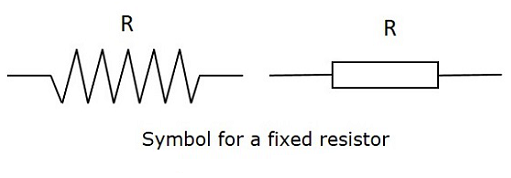
The fixed resistors are classified into different types, depending upon their manufacturing processes and the materials used in their manufacturing. The classification is as follows.
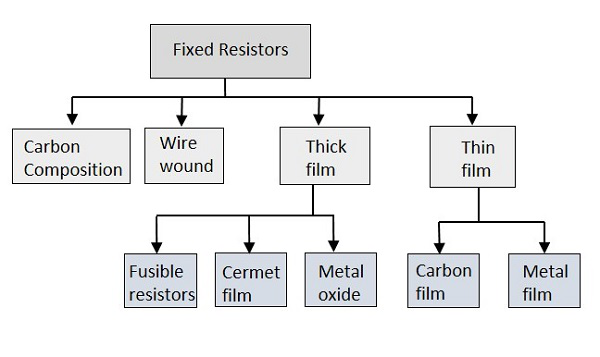
Carbon composition
The Carbon composition resistors are a blend of carbon particles, graphite and ceramic dust mixed with a binder substance like clay. This mixture is treated with high pressure and temperature. After the whole thing is molded in a case, the leads are fixed.
Thermal mass of the carbon composition resistor is higher so as to withstand high energy pulses.
These resistors have low stability and high noise which is a disadvantage.
The following figure shows an image of carbon composition resistor.
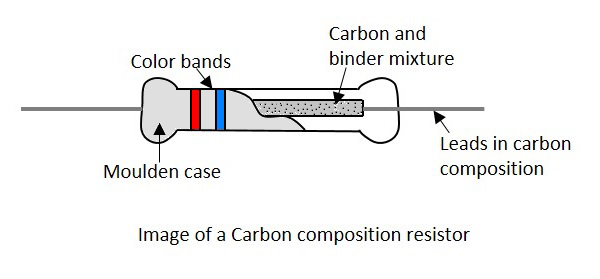
Carbon composition resistors are used in Surge protection, Current limiting, and High voltage power supplies.
Wire wound
A Wire wound resistor is formed by wounding a wire made up of a resistive material around a core. The metallic core acts as a non-conductive material while the resistive wire conducts, but with some resistance. The image of a wire wound resistor is as shown below.
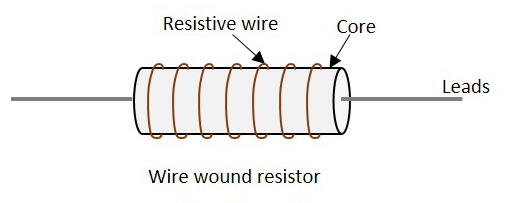
Usually a nichrome wire or a manganin wire is used to wind the core because they offer high resistance. Whereas plastic, ceramic or glass is used for core.
- Wire wound resistors are very accurate.
- They work excellently for low resistance values and high power ratings.
These are the oldest type of fixed resistors, but are being used even now.
Thick Film
The film resistors have a resistive layer on a ceramic base, whose thickness defines the type they belong to. The thickness of resistive layer on thick film resistors is much higher than thin film resistors. Thick film resistors are produced by firing a special paste, which is a mixture of glass and metal oxides, onto the substrate.
There are three main types in thick film resistors like Fusible resistors, Cermet film resistors, and Metal oxide film resistors.
Fusible Resistors
The Fusible resistors are similar to wire wound resistors. But these resistors along with providing resistance, act as a fuse. The image of a fusible resistor is as shown below.
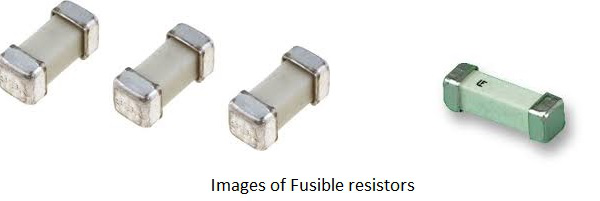
In this resistor, the current flows through a spring loaded connection, which is placed closely to the body of the resistor. The blob that is attached to the spring wire of the resistor takes the heat generated by the resistor due to the current flow. If this heat is increased, the attachment to the blob gets melted up and opens the connection.
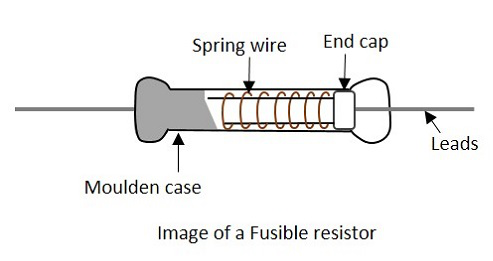
Hence we can say that, these resistors limit the current, but if the circuit power rating exceeds a specified value, these resistors act as a fuse to open or break the circuit. The value of these resistors is usually of less than 10 Ohms. These resistors are generally used in TV sets, amplifiers and other expensive electronic circuits.
Cermet Film Resistors
The Cermet film resistors are the film resistors made up of a special material called Cermet. Cermet is a composite alloy made by combining Ceramic and Metal. This combination provides the advantages in both of these materials like high temperature resistance and wear resistance of ceramic along with flexibility and electrical conductivity of a metal.
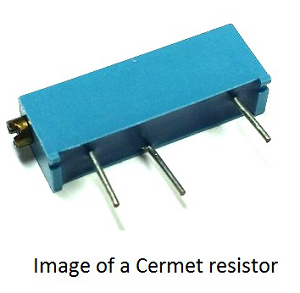
A metal film layer is wrapped around a resistive material and is fixed in a ceramic metal or cermet substrate. Leads are taken to make the connections easy while fixing on a PCB. They offer high stability as temperature cannot affect their performance.
Metal Oxide film resistors
A Metal oxide film resistor is formed by oxidizing a thick film of Tin chloride on a heated glass rod, which is a substrate. They have high temperature stability and can be used at high voltages. These resistors have low operating noise.
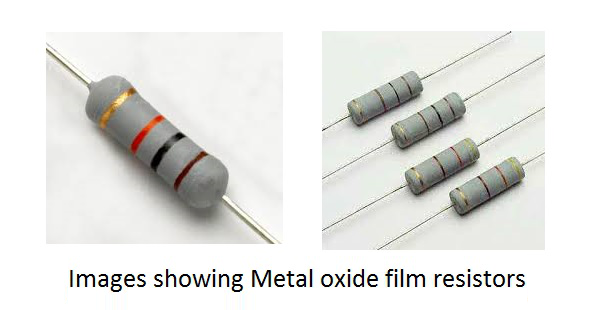
Metal oxide film resistors differ with metal film ones only regarding the type of film coated. Metal oxide is a metallic compound like tin with oxygen to form tin oxide, which is coated as a film on the resistor. The resistivity of this resistor depends upon the amount of antimony oxide added to the tin oxide.
Thin Film
Thin film resistors have a resistive layer of width 0.1 micrometer or smaller on the ceramic base. Thin film resistors have a metallic film that is vacuum deposited on an insulating substrate.
Thin film resistors are more accurate and have better temperature coefficient and is more stable. The thin film resistors are further divided into two types such as −
- Carbon film resistors
- Metal film resistors
Carbon film resistor
A Carbon film resistor is made by depositing a carbon film layer on a ceramic substrate. The carbon film acts as the resistive material to the current and the ceramic substance acts as an insulating substance. Metallic caps are fixed at both the ends and copper leads are drawn out.
The following figure shows the construction of a carbon film resistor.
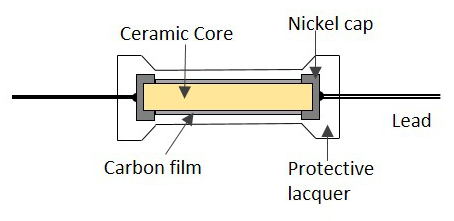
The main advantages of these resistors are their high stability, wide operating range, low noise, and low cost. The carbon film resistors are the most preferred ones over carbon composition resistors due to their low noise.
Metal Film Resistors
The film coating makes the difference between metal oxide film resistors and metal film resistors. A thin film of metallic substance such as nickel chromium is used to coat the resistor in a metal film resistor whereas a film of metal oxide like tin oxide is used to coat the resistor in a metal oxide resistor.
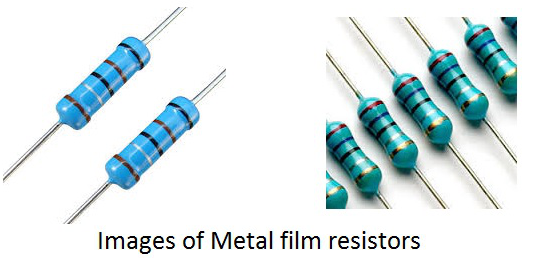
Metal film resistors have low temperature coefficient of resistance, which means the resistance is less affected by the temperature.
Wattage
While using a resistor, if the flow of current increases, the resistor dissipates some heat. If this value crosses a certain critical value, the resistor may get damaged. The wattage rating of a resistor is printed on some higher value resistors in order to avoid such situation.
Wattage is the amount of electric power expressed in watts. Electric power is the rate of transfer of electrical energy.
Power P = VI = I2R